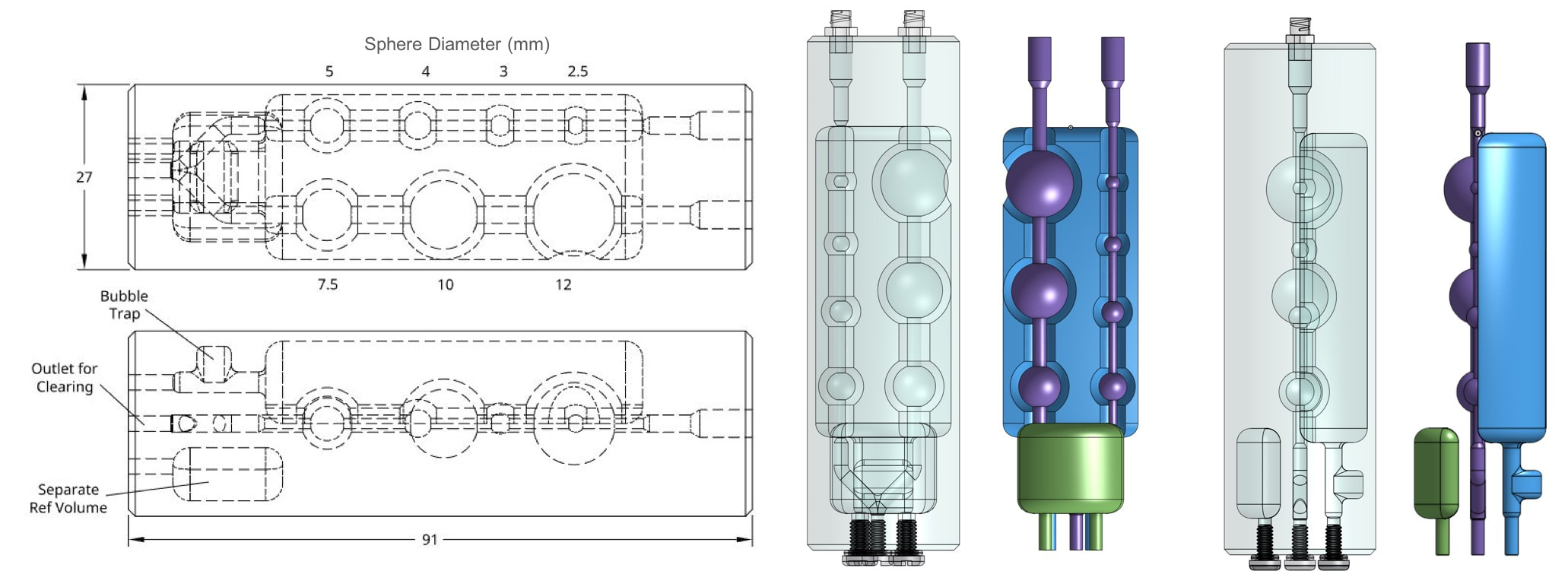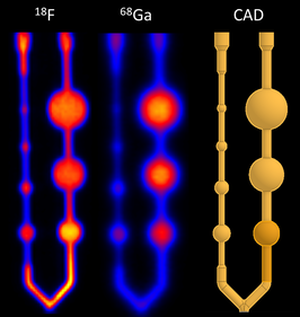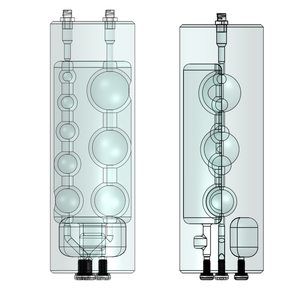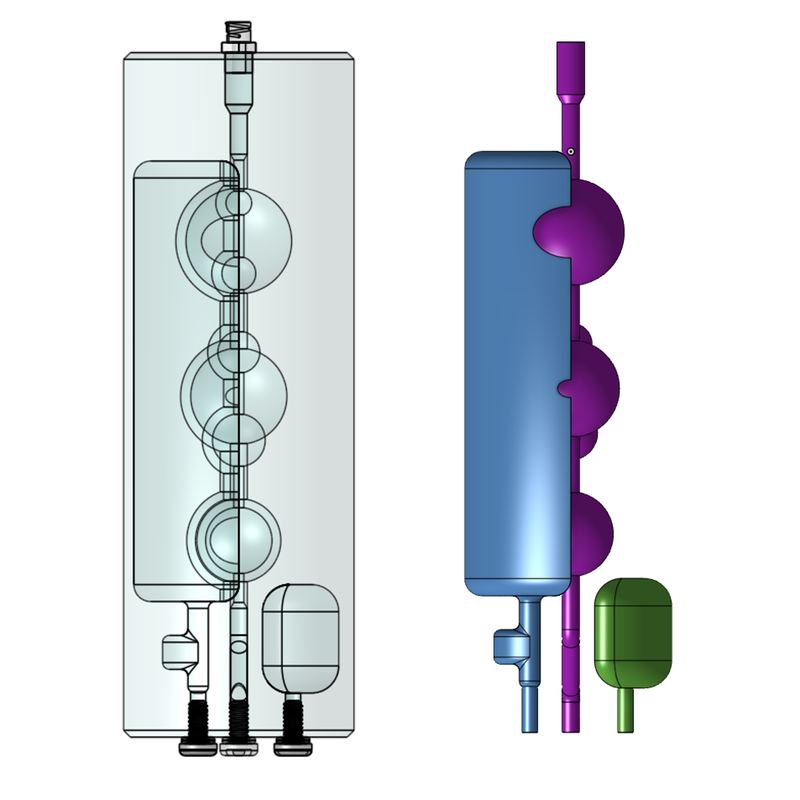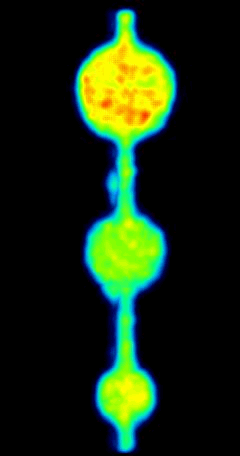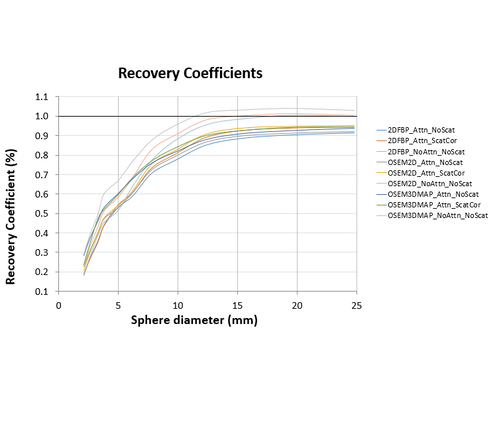Innovative Design
Phantech’s Partial Volume Correction (PVC) phantoms are used to generate recovery coefficient (RC) calibration curves. By comparing the measured activity concentration in each sphere to the known activity concentration, one can characterize the signal recovered as a function of sphere size (simulating tumors & organs) by an imaging system and then apply a correction factor. Quantitative accuracy is critical for molecular imaging research and theranostic personalized medicine.
Designed with one continuous channel connecting numerous precise spherical or ellipsoidal volumes, Phantech's PVC phantoms allow for quick, easy and safe filling.
See this video showing the filling of Phantech's Partial Volume Correction (PVC) phantom in <1 minute with no air bubbles!
Our PVC phantoms come standard with a large internal reference calibration void that is "100%" recovered, and each sphere can be normalized to this reference void. This internal calibration method allows for a more robust and standardized method of generating RC curves because the RC accuracy is not dependent on the accuracy of another calibration device. Alternatively, RCs can be generated by comparing the activity concentration of the spheres to the true activity concentration. Our PVC phantoms also contain more measurements points (spheres) than any other PVC phantoms on the market to create the most accurate RC curves.
Our PVC phantoms are available in 3 sizes, a 27 mm diameter, a 34 mm diameter, and a 49 mm diameter, as detailed below. Contact us today for availability, lead times, and pricing. Need a custom size? Contact us about custom pricing. Options include a full 360 ̊ or half 180 ̊ sleeve for a "warm" spill-in compartment, a second channel of "micro-spheres", and additional ellipsoidal PVC phantoms with varying aspect ratios (i.e. 1:2 & 2:3) to create a comprehensive 3D recovery coefficient correction curve.
Designed with one continuous channel connecting numerous precise spherical or ellipsoidal volumes, Phantech's PVC phantoms allow for quick, easy and safe filling.
See this video showing the filling of Phantech's Partial Volume Correction (PVC) phantom in <1 minute with no air bubbles!
Our PVC phantoms come standard with a large internal reference calibration void that is "100%" recovered, and each sphere can be normalized to this reference void. This internal calibration method allows for a more robust and standardized method of generating RC curves because the RC accuracy is not dependent on the accuracy of another calibration device. Alternatively, RCs can be generated by comparing the activity concentration of the spheres to the true activity concentration. Our PVC phantoms also contain more measurements points (spheres) than any other PVC phantoms on the market to create the most accurate RC curves.
Our PVC phantoms are available in 3 sizes, a 27 mm diameter, a 34 mm diameter, and a 49 mm diameter, as detailed below. Contact us today for availability, lead times, and pricing. Need a custom size? Contact us about custom pricing. Options include a full 360 ̊ or half 180 ̊ sleeve for a "warm" spill-in compartment, a second channel of "micro-spheres", and additional ellipsoidal PVC phantoms with varying aspect ratios (i.e. 1:2 & 2:3) to create a comprehensive 3D recovery coefficient correction curve.
Example micro-PVC phantom with an outer diameter (OD) of 27 mm. Three separately fillable volumes, include a chain of spherical voids, a reference volume, and a warm background. See the table below for available sizes.
Available Sizes
Outer Diameter (mm) |
Sphere Diameters (mm) |
Volumes (mL)* |
Product Number |
27 |
2.5, 3, 4, 5, 7.5, 10, 12 |
2.43, 1.79, 10.36 |
PVC27 |
34 |
3.8, 5, 6.2, 7.8, 9.8, 12.4, 14.2, 15.6 |
6.10, 3.41, 19.36 |
PVC34 |
49 |
3.8, 5, 6.2, 7.8, 9.8, 12.4, 15.6, 19.6, 24.8 |
16.64, 11.08, 59.00 |
PVC49 |
*Volumes match the figure above, including sphere void chain (purple), reference volume (green), and background (blue)
Gallery
|
F18 PET image (left), Ga68 PET image (center), and a CAD rendering of the spherical voids in the PVC27
|
Computer-aided design (CAD) rendering of our 34 mm OD PVC phantom, including a front view (left) and a side view (right)
|
CAD rendering (left) of the 34 mm OD PVC Phantom, next to a CAD rendering (right) of the three fillable volumes
|
Additional Info
What are Partial Volume Effects (PVEs)?
PVEs are an inherent physical phenomenon present in all imaging systems largely due to sampling, blurring, motion, and physical hardware constraints. However, in nuclear medicine (particularly with PET and SPECT imaging), PVEs are compounded by a radioisotope’s finite positron emission energy and its respective inherent mean positron range. For a radioisotope with a relatively short positron range (ie. 18F in a static system, the intrinsic spatial resolution of the PET scanner will have a greater influence on partial volume effects (PVEs) than the positron range of the radioisotope. On the other hand, radioisotopes with relatively long positron ranges (ie. 124I, 89Zr) are largely responsible for PVEs due to the displacement of the originating positron emission voxel to the detected annihilation voxel. In either case, PVEs play a major role in the precision and accuracy of quantitative PET data, particularly with the degradation of measured radiotracer concentration in smaller structures using radioisotopes with long positron ranges.
Why do I need to correct for PVEs?
PVEs contribute to imprecise and inaccurate quantitative data in ALL of the approximately 2 million clinical positron emission tomography (PET) and ~14.5 million single-photon emission computed tomography (SPECT) scans per year, and tens of millions of preclinical PET and SPECT scans per year. Clinically, not correcting for PVEs can have serious negative consequences on patient management and outcomes, including but not limited to, progressive disease, radiotoxicity of normal tissue in theranostic applications, erroneous staging and prognosis, and the inability to compare data in multi-site trials, which collectively contribute to increased healthcare costs. Preclinically, not correcting for PVEs can have serious negative consequences as well, including but not limited to, erroneous data interpretation and conclusions, radiotoxicity of normal tissue in theranostic applications, and the inability to compare data between institutions.

